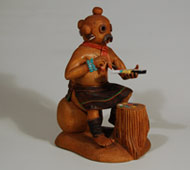Adobe Gallery Blog
Subject: Hopi Seated Mudhead Painting a Tihu
 The Koyemsi are best known as Mudheads because of the color of their head coverings. The Koyemsi were imported from Zuni Pueblo in the late 1800s by the Hopi to replace their equivalent one called Tachuki, which no longer exists at Hopi. Only the Zuni-style Koyemsi exists at Hopi now. The name Mudhead is an English name given by traders and others.
The Koyemsi are best known as Mudheads because of the color of their head coverings. The Koyemsi were imported from Zuni Pueblo in the late 1800s by the Hopi to replace their equivalent one called Tachuki, which no longer exists at Hopi. Only the Zuni-style Koyemsi exists at Hopi now. The name Mudhead is an English name given by traders and others.
Legend has it that Koyemsi were born of an incestuous union between brother and sister and the knots on their head are deformity as a result of the relationship.
According to Barton Wright "The Koyemsi are not considered to be Kachinas and they live in a separate location...near the kachinas home...but are not a part of them."
The Koyemsi are not clowns in the manner of the Koshari. When the Koyemsi "clown around" it is in the guise of playing games with children or even adults, not being buffoons.
In this presentation of a Katsina doll, Ronald Honyouti has correctly dressed the Mudhead in the black woman's manta, a fragment of which is worn as a kilt. The Mudhead is painting a flat katsina doll (tihu) of Hahai-i-Wuhti, which will be a present to a Hopi child during the Powamu Ceremony in February. Hahai-i-Wuhti is the first Katsina doll presented to a newborn.
Amazingly, the entire doll appears to have been carved from a single cottonwood root. The paint brush is the only added feature. When one attempts a carving as complicated as this, there is no room for a mistake. It must be planned carefully and accurately, which is what Honyouti certainly did. Ronald Honyouti and his brothers, Loren and Brian, are considered among the finest katsina doll carvers on the reservation and one can certainly see the reason when viewing this magnificent carving.
Condition: original condition
Provenance: from the estate of a family from Kentucky
Recommended Reading: Clowns of the Hopi: Tradition Keepers and Delight Makers by Barton Wright
Subject: Hopi Seated Mudhead Painting a Tihu
Artist / Carver: Ronald Honyouti (b.1955)
Category: Traditional
Origin: Hopi Pueblo
Medium: cottonwood root, stain, paint
Size: 9" tall; 6-3/8" x 5-3/8" pedestal
Item # C3379A

